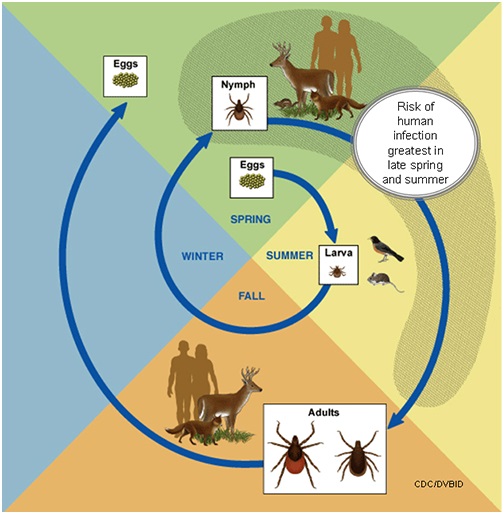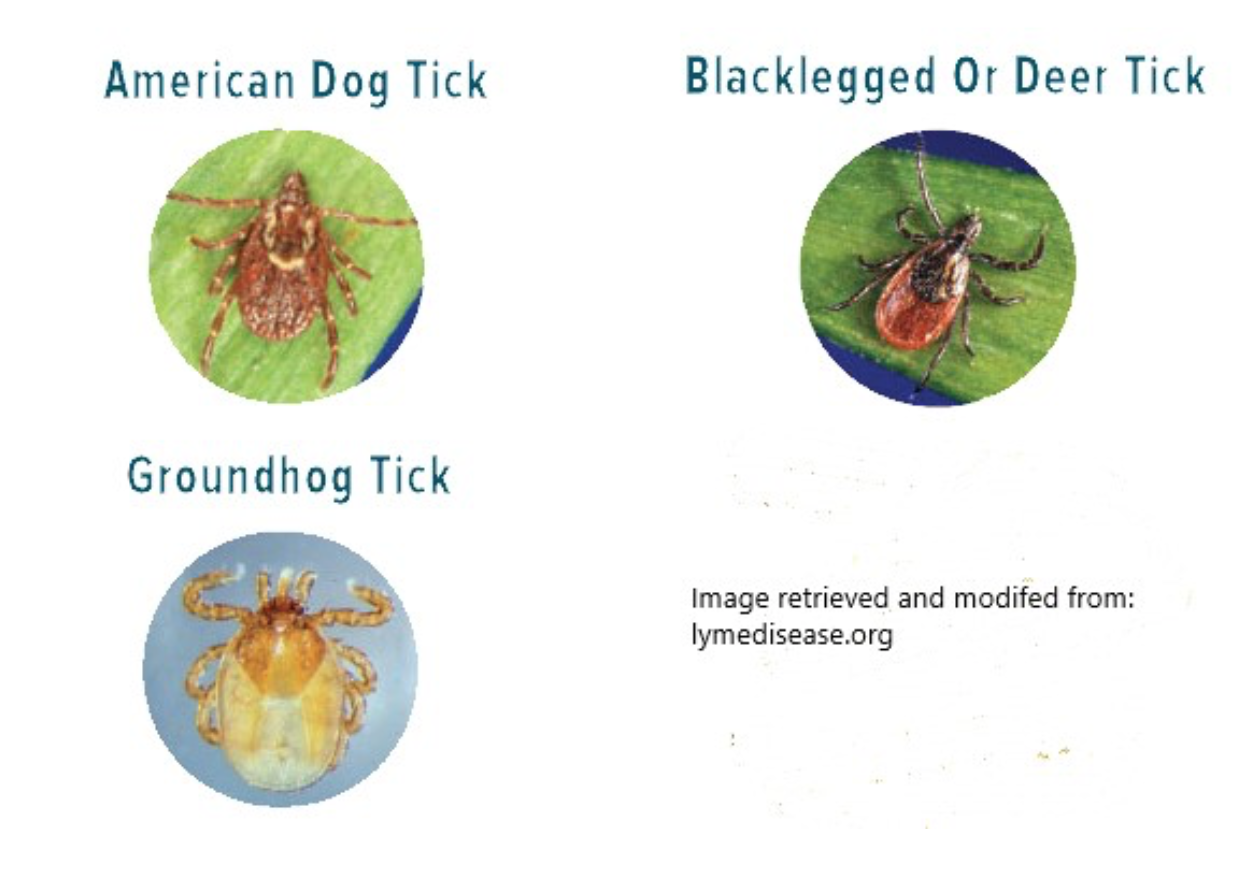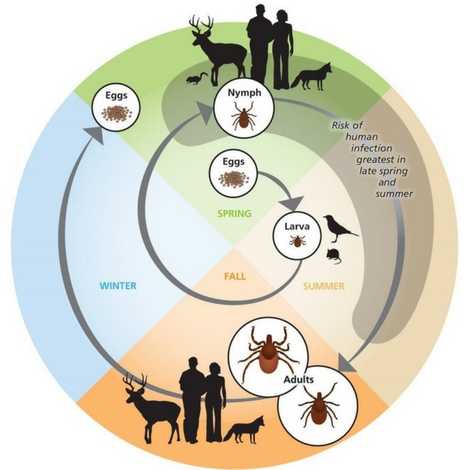tick life cycle canada
It primarily infests dogs but can feed on other mammals including man. The following stages of tick development are distinguished.

Ticks What Do I Need To Know As An Atlantic Canadian Mountain Road Animal Hospital
It begins in early.

. Ticks have 4 distinct stages to their life cycle. Immature ticks nymphs are responsible for most human ld infections because their very small size hinders detection. Stages in the Life Cycle of Ticks The First Stage egg The adult female tick first fulfills a proper blood meal then the process of mating occurs between an adult male and adult female tick.
Tick life cycle canada. Most of the ticks that carry disease live two to three years and feed on the blood of multiple hosts across their four-stage life cycle which progresses from egg to larva to nymph to adult. Check the whole body.
The Rocky Mountain wood tick is a three-host tick a new host being sought for each one of its three feedings which occur over a period of 1 to 3 years. Its important to be familiar with this life cycle to get rid of ticks from your lawn and landscape and prevent tick bites. Ticks come in various sizes and shapes based on the stage of life they are at.
The majority of hard ticks require three different hosts to complete their development. Unlike the other species of ticks its life cycle allows it to survive and develop indoors which means it can establish itself in colder climates. It may be helpful to have someone else.
The eggs hatch and six-legged larvae emerge from the eggs. Lone star tick Amblyomma americanum figure 3 EF found in south eastern and south central United States. Adult Females deposit from 3000 to 6000 eggs on the ground.
A tick goes through a similar life cycle as other arthropods as the metamorphosis starts at the egg stage moves to larval stages then to the nymphal stage and finally to adult. This cycle also requires three different hosts and requires at least 54 days to complete but can take up to two years depending on the host availability host location and the temperature. The life cycle of a tick is completed after four stages namely egg larva nymph and adult it requires more than a year to complete a full life cycle.
Usually rodents and other small animals serve for the first two feedings and large animals such as deer cattle dogs sheep and humans serve as the host for the last feeding. The lifecycle of Ixodes scapularis ticks generally lasts two years. Fabaceae Pea Life cycle.
This is found world-wide all over the US and also southeast Canada and can complete its entire life cycle indoors. Generally adult female hard ticks breed while on the host animal and then drop to the ground to lay eggs. They can be found across the eastern half of the united states and into southern portions of canada and have a two year life cycle.
Gravid pregnant female ticks lay batches of up. Ticks life cycle Like all arachnids ticks have a clear division into females and males. Eggs Larva Nymph Adult.
The blacklegged tick or deer tick Ixodes scapularis is one of the most important ticks in the Northeast for human and animal health. DO THE TICK CHECK Ticks prefer warm moist dark areas of the body. A hot room or on a hot windowsill.
Ticks have four distinct life stages. That gives them plenty of opportunity to pick up a pathogen that they can later transmit through their saliva when they bite someone. Ticks have a two year life cycle.
Ticks are found in many areas across Canada including southern Ontario. Female adults die after egg-laying is complete. They can be found across the eastern half of the United States and into southern portions of.
Two of the most common types are Black Legged ticks formerly know as the Deer Tick and the American Dog tick. They need the dry to die. A tick needs to feed before growing to the next stage of its life cycle.
Ticks begin questing looking for a blood meal when temperatures reach 4oC and higher. The ticks will dry out and die within 24 hours. Most of the ticks that carry disease live two to three years and feed on the blood of multiple hosts across their four-stage life cycle which progresses from egg to larva to nymph to adult.
At this stage of life these small ticks about 18-inch in size have six legs instead of the eight legs they will have later on in their lives. That gives them plenty of opportunity to pick up a pathogen that they can later transmit through their saliva when they bite someone. Blacklegged ticks can feed from mammals birds reptiles and amphibians.
The brown dog tick also known as the kennel tick is found through most of the United States and Canada. Black Legged ticks are the common vector for Lyme Disease. Prairies along shores along roads railroads open woods.
Male hard ticks usually die after mating with one or more females although some may live for several months. Average to moist sandy or rocky soil. Each stage of the life cycle requires a blood meal to develop and eggs typically hatch into six-legged larvae after a period of four to 10 days.
It can attack you in transport if the tick was on the clothes of other people returning from the forest. Egg Larvae Nymph and Adult. During this development ticks go through four stages of life.
All larvae are born with six legs. 2 to 6 feet. Ixodes scapularis the black-legged deer tick which is the primary vector for Lyme disease has a four-stage life cycle and a lifespan of about two years.
When an egg first hatches as a larva it requires a blood meal to mature. Blacklegged ticks are common species and the primary vectors for Lyme disease Anaplasmosis Babesiosis and other illnesses. These stages are egg larvae or seed tick nymph and adult.
The cycle requires a blood meal before progression from larva to nymph from nymph to adult and by the adult for egg production. Ticks have 4 life stages. Hoary Tick-trefoil Canada Tick-clover.
THE BASIC LIFE CYCLE OF TICKS Ticks mature in four stages moving from egg to larva and nymph to adult. Female ticks lay thousands of eggs on the ground which then hatch into larvae known as seed ticks. Use a Chewable Proven to Kill the Ticks That Transmit Lyme Disease More.
1 The Egg Stage 1 After the adult female tick has acquired a proper blood meal she mates with the adult male tick leaves the host and searches for a suitable spot to lay her eggs. Ad Try a Chewable That Kills The Ticks That Transmit Lyme Disease Other Parasites. This tick feeds on dogs but rarely bites people or cats.
Ticks can transmit disease such as Lyme to animals and people when. The Ixodes scapularis ticks that transmit Lyme disease in Eastern regions of the United States and Canada have a two-year life cycle. The most interesting life cycle is monitored in bloodsucking species.
This is the safest way to handle your outdoor clothing as ticks can survive a full cycle in the washing machine. Egg larvae nymph and adult. There are dozens of different tick species that are commonly found across Canada.
However some species of larvae can live for months without maturing or finding a blood meal. 2 The Larvae Stage 2. After the eggs hatch the ticks must have a blood meal at every stage to survive.
Life Cycle of Ticks. Adult ticks seek host animals and after engorgement on blood mate. During this time they go through four life stages.
Egg larva nymph and adult.

Life Cycle Of Tick Bug With Its Common Hosts And Human With Lyme Disease Which Is

Life Cycle Of Ixodes Ricinus And Transmission Of Rodent Associated Download Scientific Diagram

Life Cycle Of The Ixodes Tick Vectors Of Lyme Borreliosis Reservoir Download Scientific Diagram
Tick Control And Disease Prevention Deerbusters Canada

Update Protecting Yourself Your Dog From Ticks Toronto 2020 Royal York Animal Hospital

Ticks Lyme Disease And Our Pets St David S Veterinary Clinic

